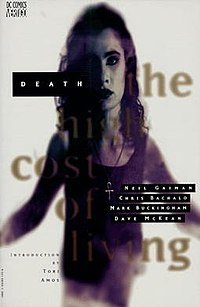Death and Me
| Death: The High Cost of Living | |
|---|---|

Cover of Death: The High Cost of Living TPB.
Art by Dave McKean, featuring Tori Amos |
|
| Publication information | |
| Publisher | Vertigo Comics |
| Format | Limited series |
| Publication date | March, 1993 - May, 1993 |
| No. of issues | 3 |
| Main character(s) | Death of the Endless |
| Creative team | |
| Created by |
Neil Gaiman Mike Dringenberg |
| Written by | Neil Gaiman |
| Penciller(s) | Chris Bachalo |
| Inker(s) | Mark Buckingham |
| Letterer(s) | Todd Klein |
| Colorist(s) | Steve Oliff |
| Editor(s) |
Karen Berger Lisa Aufenanger |
| Collected editions | |
| HC (Nov 1993) | ISBN |
| TPB (Jun 1994) | ISBN |
Death: The High Cost of Living is a comic, written by Neil Gaiman with art by Chris Bachalo and Mark Buckingham. It is a spin-off from Gaiman's best-selling Vertigo Comics series The Sandman, featuring the Sandman (Dream)'s elder sister, Death of the Endless. Its premise is that Death takes human form once a century, to remain grounded and in touch with humanity, an idea touched upon in several other media, for example in the 1934 film Death Takes a Holiday and in the Terry Pratchett novel Reaper Man.
A movie based on this series has been in the works for several years in various stages of development and until recently was in the works at New Line Cinema. Gaiman had previously confirmed that this movie was in progress and that he was planning on writing the script and directing it, with Guillermo del Toro as executive producer. The film, which is currently on hold, was operating under the title Death and Me.
Death: The High Cost of Living was originally published as a three-issue comic book miniseries, published monthly by Vertigo, DC Comics' mature readers imprint and cover-dated March to May 1993. It was the first stand-alone mini-series derived from the then-on-going Sandman series by Gaiman, and was written by him with artwork by Bachalo and Buckingham and covers by regular Sandman cover artist Dave McKean. The High Cost of Living was one of the first new titles published under the newly created Vertigo imprint, alongside Peter Milligan's Enigma, and is also notable for being one of the very few Vertigo comics to feature an alternative cover, as #1 did. Vertigo's other output in its debut month consisted of a half-dozen continuing DC series, newly moved to the mature imprint. These continuing series' included Hellblazer and Gaiman's own The Sandman.
...
Wikipedia
